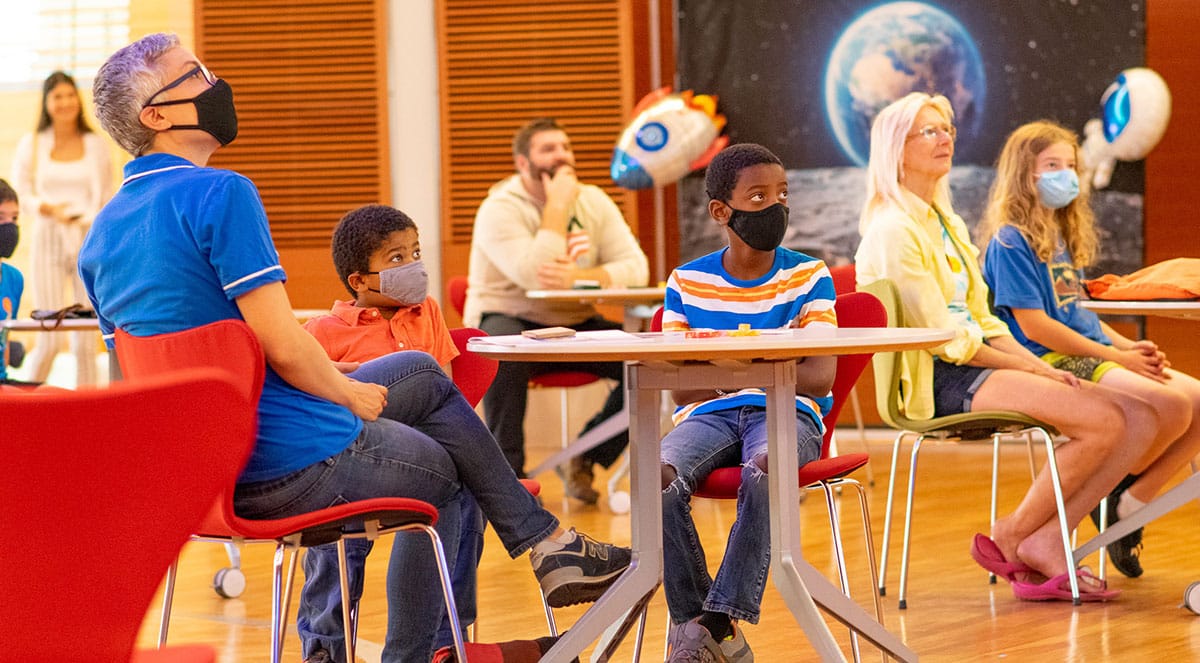How does it feel to fly through an aurora, or look down at a shooting star?
Does a space station smell?
Between gravity-defying somersaults, astronauts aboard the International Space Station addressed these and other questions from Wisconsin students during a riveting live video downlink on July 13.
The real-time event was accessible to all families and K-12 students throughout the state and capped a series of summer camps and workshops hosted by Discovery Outreach, a partnership between WARF and the Morgridge Institute.
A watch party at the Discovery Building on campus attracted dozens of curious spectators and NASA groupies alike. Lieutenant Governor Mandela Barnes kicked off the event, which is part of a statewide initiative to provide Wisconsin youth with authentic science experiences.
Hurtling at 17,500 miles per hour through Earth’s thermosphere, the Space Station is a living laboratory, where the sun rises and sets 16 times a day. Continuously inhabited for 20 years, more than 240 visitors from 19 countries have called it home (average tenure is six months).
Presently aboard, astronauts Shane Kimbrough and Aki Hoshide demonstrated for students the delights and challenges of living in microgravity – where juice turns into a floating blob, plant roots grow sideways, and sleeping bags must be lashed down.
“We hope that from experiences like this that everyone in Wisconsin can explore their curiosity and feel the excitement of discovery, see that they can bravely ask big questions and participate in science and experience science from right here in Wisconsin that made it all the way up into space. It is moments like these that can inspire for a lifetime.”
Dan Murphy
Participants learned how astronaut meals are prepared ahead of time by a forensically-gowned team of specialists who shop, cook and dehydrate the food (removing the water from a single spaghetti dinner, for example, can cut the transportation cost from $10,000 to $600). Interestingly, tortillas are preferred to bread (too crumbly).
Tricked out with solar arrays the size of football fields, the Space Station has the volume of a five-bedroom house or two Boeing 747 jetliners. And not all the life aboard is human – current experiments here include a species of micro-animals called tardigrades (or water bears) as well as cotton plants.
The latter research is led (down on Earth) by UW–Madison botanist Simon Gilroy. His lab seeks to understand how root systems grow under the unique stresses of zero gravity. According to UW, the research, funded by Target, may help scientists learn how to more efficiently grow the crop (it takes up to 800 gallons of water to produce the cotton for one T-shirt).
This research is also vital for understanding how to prepare for longer-term space missions with fresh foods grown in flight or on other planets.
Biology gets lazy in space, explained Gilroy. “Plants lose their woody toughness.”
Many of the students involved in the July 13 event participated in Discovery Outreach programs focused on STEM identity. The programs, which were based on the theme “There’s Space for Everyone in STEM,” highlighted the many ways we’re all connected to science and the opportunities in STEM.
“This event speaks to the heart of Discovery Outreach and public science engagement,” said Dan Murphy, outreach and lab manager for the Morgridge Institute for Research. “We hope that from experiences like this that everyone in Wisconsin can explore their curiosity and feel the excitement of discovery, see that they can bravely ask big questions and participate in science and experience science from right here in Wisconsin that made it all the way up into space. It is moments like these that can inspire for a lifetime.”
